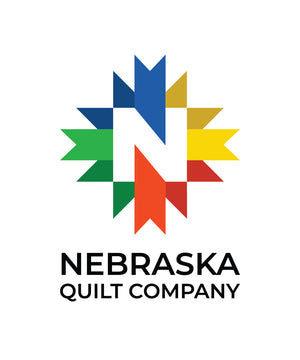A well-designed quilt pattern is a joy to follow. Using a great pattern is probably the best way to get into quilting. A thoughtfully written pattern will provide clear instructions for cutting, piecing, pressing, and assembling a quilt top. You already know that your local quilt shop can guide you to a great pattern and help you pick fabrics that suit your style.
Once you’ve made several quilts, however, you might start itching to create something completely unique. Maybe you have an idea for a design that you’ve never seen a pattern for. Are you ready for your next quilt adventure?
Be Fearless- Design Your Own Quilt!
To start, all you need to keep in mind is that quilting has always been based on shared, adapted, and repeated designs. There’s no need to be intimidated; people have been making and remaking quilt designs for centuries!
For example, take a look at this gorgeous sherbet-rainbow log cabin quilt that we recently had in the shop. This thoroughly modern quilt has direct roots in the late 1800s, when log cabin quilts emerged as a popular way to celebrate Abraham Lincoln, who famously was raised in a log cabin in Indiana.

A vibrant, colorful log cabin quilt shared on the NQC Facebook Page.
Compare the rainbow log cabin quilt to this log cabin example, made around 1870 by an unknown quilter in Boston, Massachusetts. The sizes of the blocks differ and the color choices are obviously from different times, but the building block- the log cabin- is the same.

Log Cabin Quilt held by The Huntington Library
With the tradition of copying and adapting in mind, pick a favorite block as your starting point. Choose one that you’ve already made.. You know how to construct it, so you can be comfortable with cutting, piecing and pressing to create the complete block. With this grounding in a familiar block, it’s time to get creative.
Audition Your Quilt Design Ideas
Now it’s time to play! Let out your inner kindergartener and grab your art supplies. Printer paper, colored pencils, crayons, construction paper, glue, tape, and scissors will all come in handy. Either use construction paper to cut out the shapes that make up the block or draw and color your block on a sheet of plain paper.
Look for design inspiration. Search the name of your quilt block on a search engine or on social media. Do you want your quilt to have symbolic meaning? Perhaps the number of blocks represents the number of kids or grandkids in a family?
Give yourself time to create options, walk away, and return later to reevaluate each arrangement. Once you have a block size and color scheme that you like, snap a photo and upload it to your computer.
No need to worry here: you aren’t going to need sophisticated photo editing software. Any program or website that lets you pick up, move, and resize images will work just fine. Some examples we like: Google Slides, PowerPoint, and Canva.
Import your block photo into your file. Make several copies of the block. Now start playing with the size, quantity, and layout of your motifs. You can mix large, medium, and small versions of your motif on the quilt. Also consider symmetry. Are you someone who likes to play with asymmetry, or do you prefer the regularity of a fully symmetrical pattern?
Generally, if you repeat the same size motif in a grid on your project, the quilt will read as more traditional. If you experiment with symmetry or vary the block/motif sizes, you’re creating something more modern. Fabric and color choices will also influence whether your quilt looks more modern or traditional.
As you play with layout, you should also start thinking about the size you ultimately want to make. Since this is your first foray into quilt design, you can set yourself up for success by planning a smaller piece: maybe a wall hanging, table topper, or baby quilt.
Time for Quilt Math!
Love it or hate it, quilt math is a necessary part of the process for a few reasons. First, you need to know the size of your finished project. Second, you need to know how much fabric to buy or source from your stash. To get this information, we recommend using an online tool. There are plenty out there; here are a few that might work for your needs:
PreQuilt (free and paid versions) Cool feature: audition fabrics from connected manufacturers’ libraries.
Quilt Assistant (free, PC only) Great for drafting symmetrical blocks and also for turning photos into quilts.
EQ8 (paid) Electric Quilt 8 is chock-full of features, but also has a steep learning curve.
If you’re not sure which option to use, ask around! Your experienced quilter friends and the staff at your local quilt shop should be able to give you recommendations for what works best for them.
Once you have your fabric selected and your layout prepared, you can start cutting! Enjoy the journey and let yourself learn as you go. If you tend to be a perfectionist, give yourself a break! You’re learning something new and you’re doing something that only experienced, patient, and careful quilters can do: design and make a complete custom quilt!
Share Your Quilt Design
As you work on your new design, we’d love for you to share your progress in the Nebraska Quilt Company Facebook Community or on Instagram.
Nebraska Quilt Company is your source for classes, sewing machines, quilt kits, and more! Visit us online or in store today.

